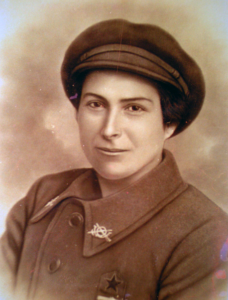Yes, Women Did Serve in the People’s Army of the Spanish Republic: Esther Gutiérrez Escoda Sets the Record Straight

Encarnación Luna, comisario de la 11 División (23 de julio de 1938). Photo Díaz Casariego. Causa General, CDMH.
For more than 80 years, historians have ignored the important role played by thousands of women soldiers in the People’s Army of the Spanish Republic. A new dissertation takes a crucial first step to correct the record.
“Every study on the topic—even by feminist historians—has assumed that, once the militias were disbanded in late 1936, the Spanish Republican army systematically excluded women from its ranks. That’s simply not true. I have documented no fewer than 3,603 female military who were officially recognized as such by the Republican authorities—and that’s only the tip of the iceberg.”
Esther Gutiérrez Escoda, who holds a BA in History and for most of her life has worked as a gardener, recently earned her Ph. D at the Universitat Rovira i Virgili in Tarragona (Catalonia) with a groundbreaking thesis about the role of women in the military defense of the Spanish Republic during the war of 1936-39. “Most of the thesis was new to me,” says Paul Preston, who served on the defense tribunal. “I was greatly impressed. The research is impeccable.” The dissertation earned Gutiérrez Escoda a summa cum laude; it will be published in a trade edition by Crítica. I spoke with the author in June.
You argue that most historical research about women in the Republican army has been marred by “gaps and distortions.”
The most salient gap has been, precisely, the sheer invisibility of women in the military. Historians have been wrong to assume that there were no women in the Republican army. But the role of women in the war has been systematically distorted more broadly.
This distortion, you point out, was made possible through three concepts: milicianas, domestic labor, and the rearguard.
Starting in the fall of 1936, the militias, which consisted of volunteers, were incorporated into the regular Republican army. At that point, historians stop referring to the men as milicianos, calling them soldiers instead. Yet at the same time, they keep referring to the women as milicianas. This falsely implies that the women continued to be part of a volunteer fighting force instead of the regular army.
A similar distortion occurred when it came to describing the soldiers’ responsibilities. It’s often said that women in the army were solely tasked with domestic chores. But while male soldiers who worked as cooks, office workers, intendents or cleaning stables and latrines were assumed to be doing military work, when women soldiers were put in charge of those same tasks, their work was no longer described as a military assignment but simply as “domestic labor.”
In other words, historians’ interpretations of both women’s status and their work has been gendered from the outset.
Exactly. We can say the same thing when it comes to the concept of the rearguard. Historians have tended to interpret the rearguard as a civilian zone. The truth is that it was part of the war zone. Although it was farther removed from the enemy, it was still dominated by the army. With medical workers, something similar has occurred. The women who served as nurses, doctors, veterinarians, or pharmacists have been defined as “caretakers,” even when they were in fact soldiers. The same is true for the women who served as operators in the telephone service, telegraph, or radio communications. Yet they, too, were soldiers, fully integrated into the telecommunications sector of the People’s Army of the Second Republic.
How do you explain these blind spots in the historiography? Are they due to archival gaps? Do they reflect the dynamics of historical memory, or perhaps the continued weight of the Francoist legacy? Or are we simply dealing with sexism?
It’s clear that military history in particular is still weighed down with baggage from the past, including the assumption that the military is an exclusively masculine world. It’s also true that there has been a disconnect between military historians, on the one hand, and historians working on gender, on the other. As a result, women have been generally excluded from military-related research. But ignorance, simple lack of knowledge, has of course also been a factor. That said, it is true that researching the role of female military in the Spanish Civil War presents specific challenges. There is a real dearth of documentation. For one, many of the women who served “masculinized” their name, so that it’s difficult to identify them in the army’s official documentation. Secondly, most of the women who served in the army have since died. Many also went into exile or just kept silent in the face of Franco’s ruthless repression.
Plus, as you just explained, researchers today are facing decades’ worth of bias that’s been baked into the historiography, so to speak.
Yes, the historiography is rife with stubborn clichés and prejudices that are very hard to break away from. Still, it’s surprising, to say the least, that not more research has been done in this area. It’s been more than 80 years! Why haven’t historians been more curious about the women soldiers of the Second Republic?
As you point out, one of the central misunderstandings is that the Republican government under Francisco Largo Caballero banned women from the army in the fall of 1936.
Not only is that untrue, but in fact the opposite happened. As the war unfolded, the Republican authorities obliged women to militarize. It was Largo Caballero, in October 1936, who first militarized the medical services. From then on, women were gradually militarized until January 1939, when then Prime Minister Juan Negrín militarized all the remaining women who hadn’t been militarized yet.
Why has Largo Caballero’s decree from October 1936 been misunderstood for so long?
We shouldn’t forget that the first work on the role of the milicianas, by Ingrid Strobl, in the late 1980s, was written from prison and based exclusively on a sources in English and German. Stroble did not include any kind of archival documentation, not even Largo Caballero’s famous October decree. Had she consulted the original document, she’d realized, for one thing, that Largo could not have used it to expel women from the militias, given that he had no jurisdiction over the militias, which after all were controlled by the unions and political parties, not by the government. The truth is that Largo’s decree did not expel women from the Republican army. It simply legislated the process by which that army would be constituted. Which is why it should be read, precisely, as the first decree calling for an obligatory militarization of women serving in the war. The problem is that most subsequent studies have taken Strobl as their point of departure, including her misreading of the October decree. This made Largo Caballero into the bad guy. I sometimes wonder if that that was a mere misunderstanding or a willful misinterpretation.
What can you say about the women soldiers among the International Brigades?
They, too, have been eclipsed by the men, whose commitment to the defense of the Second Republic has been widely documented and acknowledged. Still today it is very difficult to determine the approximate number of non-Spanish women who served in the People’s Army. There are fewer reports in the archives on the women than on the men, and very few interviews or testimonies. The fact that many women adopted Spanish names complicates matters further. The dinamitera Josefa Pérez Herrera, for example—who belonged to the famous XIV Corps of Guerrilla Fighters, a unit that exclusively worked behind enemy lines—was in fact Elizaveta Parshina, an international volunteer from the Soviet Union.
Further, when these women are mentioned in the historiography at all, it’s often as mere “companions” of men. In other cases, they’re listed as nurses when in fact they were soldiers serving in a medical unit. And while it’s true that many international—and Spanish—women served in the medical units of the International Brigades, I also document many others who were frontline soldiers, drivers, pharmacists, teachers, and so forth.
There were differences, too. While many Spanish women masculinized their names, many international women changed their names into Spanish. More importantly, the foreign women who joined the IB did so as volunteers. This meant that, if a woman soldier in the IB wanted to leave, all she had to do was notify her superiors. The women soldiers who were Spanish faced a different situation. If they left their post, they, like their male counterparts, faced charges of desertion. Their enlistment was understood to be “for the length of the campaign,” that is, until the end of the war. Women who were called up for compulsory service and failed to report were also charged with desertion.
You explain that, once the war was over, women continued to fight in the maquis or guerrilla.
We can’t understand the maquis without the women, just like we cannot understand the development of the People’s Army without them. To make things worse, the maquis was first stigmatized by pro-Francoist pseudo-historians, and then willfully forgotten and silenced in the so-called transition to democracy. The truth is that the guerrilla war after April 1939 was a continuation of the Civil War. Francoism called the maquis “bandits” in an attempt to depoliticize its armed struggle. But the members of the maquis were neither bandits nor terrorists. The women who served in the guerrilla were former soldiers of the defeated People’s Army or women who fled Francoist repression. Many of the women I study in my thesis fought from July 1936 through early 1939, only to continue their struggle in the Spanish maquis, the French resistance to the Nazis, or as spies and saboteurs during the Second World War.
At the same time, you point out that the women who had served in the Republican army faced harsh repression from the Francoist dictatorship.
That repression was perverse, inhumane, and cruel. As the daughter and granddaughter of victims of the dictatorship, I must confess that I had a very hard time writing the chapter that details the necrophilic terror that Francoism unleashed on the vanquished. If I had to summarized it in three words, I’d say: So much horror!
The repression that women faced in the immediate postwar years—with its echoes of medieval, inquisitorial Catholicism—cannot be compared to that faced by their male counterparts. Rapes were very common, as were head-shavings, forced purges, torture, taunts, humiliations, and assassinations. Moreover, women who were charged with crimes were systematically robbed of their children. This type of inhumane treatment was imposed by Francoism on women specifically. Men were simply tortured, assassinated, or condemned to prison or forced-labor battalions. In that sense, Francoist repression was clearly differentiated by gender.
Your research has broken a lot of new ground.
I am not sure. Curiously, the overwhelming sensation I am left with, now that I’ve finished my dissertation, is that most, if not all, of the work remains to be done. I have only identified the tip of the iceberg. As I said earlier, I was able to identify 3,603 women soldiers. But that is solely based on the Republic’s official bulletins: the Gaceta de la República and the Diario Oficial del Ministerio de Defensa Nacional. I honestly believe that if we want to grant women soldiers the recognition they deserve, we must start writing the Second Republic’s military history from scratch. Breaking the silence, lifting the cloak of invisibility, and revealing the female face of battle is a debt we owe to our foremothers.

















[…] Full text at The Volunteer. […]
[…] This is an edited version of an interview with Escoda, written by Sebastiaan Faber and originally published in the September 2022 issue of The Volunteer, the magazine of the IBMT’s sister-organisation ALBA found here. […]
[…] Yes, Women Did Serve in the People’s Army of the Spanish Republic: Esther Gutiérrez Escoda Se… […]